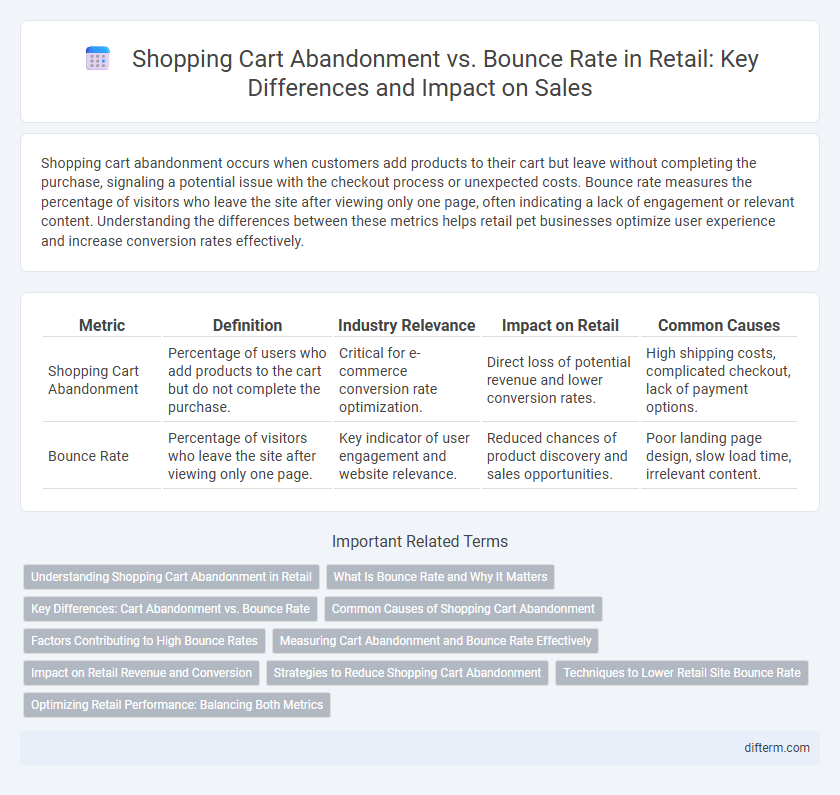Shopping cart abandonment occurs when customers add products to their cart but leave without completing the purchase, signaling a potential issue with the checkout process or unexpected costs. Bounce rate measures the percentage of visitors who leave the site after viewing only one page, often indicating a lack of engagement or relevant content. Understanding the differences between these metrics helps retail pet businesses optimize user experience and increase conversion rates effectively.
Table of Comparison
| Metric | Definition | Industry Relevance | Impact on Retail | Common Causes |
|---|---|---|---|---|
| Shopping Cart Abandonment | Percentage of users who add products to the cart but do not complete the purchase. | Critical for e-commerce conversion rate optimization. | Direct loss of potential revenue and lower conversion rates. | High shipping costs, complicated checkout, lack of payment options. |
| Bounce Rate | Percentage of visitors who leave the site after viewing only one page. | Key indicator of user engagement and website relevance. | Reduced chances of product discovery and sales opportunities. | Poor landing page design, slow load time, irrelevant content. |
Understanding Shopping Cart Abandonment in Retail
Shopping cart abandonment in retail occurs when customers add items to their online cart but leave without completing the purchase, often driven by unexpected costs, complicated checkout processes, or lack of trust in the site. Bounce rate measures the percentage of visitors who leave the site after viewing only one page, indicating potential issues with landing page relevance or site speed but not necessarily reflecting intent to buy. Understanding these metrics helps retailers optimize user experience by reducing friction points, improving site navigation, and streamlining checkout to convert more visitors into customers.
What Is Bounce Rate and Why It Matters
Bounce rate measures the percentage of visitors who leave a retail website after viewing only one page, indicating low engagement or poor user experience. A high bounce rate often signals issues such as slow load times, irrelevant content, or complicated navigation, negatively impacting conversion rates. Reducing bounce rate is crucial for improving online retail success and minimizing shopping cart abandonment by encouraging users to explore products and complete purchases.
Key Differences: Cart Abandonment vs. Bounce Rate
Shopping cart abandonment occurs when customers add items to their cart but leave without completing the purchase, reflecting a deeper engagement level than bounce rate, which measures visitors leaving a website after viewing only one page. Cart abandonment rates typically provide insights into checkout process issues, payment barriers, or unexpected costs, while bounce rate highlights poor landing page relevance or user experience. Understanding these key differences helps retailers prioritize optimization strategies for conversion funnel improvements and user retention.
Common Causes of Shopping Cart Abandonment
High shipping costs, complicated checkout processes, and lack of payment options are common causes of shopping cart abandonment in retail. Unexpected costs and a lengthy checkout experience often lead to customers leaving without completing their purchase. Improving site speed, offering transparent pricing, and streamlining checkout can reduce abandonment rates more effectively than focusing solely on bounce rate.
Factors Contributing to High Bounce Rates
High bounce rates in retail websites often stem from slow page load times, irrelevant or confusing content, and poor mobile optimization, which discourage users from exploring beyond the landing page. Complex navigation structures and intrusive pop-ups also frustrate visitors, prompting immediate exits. Understanding these factors is crucial for reducing bounce rates and increasing shopper engagement.
Measuring Cart Abandonment and Bounce Rate Effectively
Accurate measurement of shopping cart abandonment and bounce rate requires tracking user interactions through analytics tools like Google Analytics and heatmaps to identify drop-off points in the conversion funnel. Key metrics include cart abandonment rate, calculated by dividing abandoned carts by initiated checkouts, and bounce rate, the percentage of visitors leaving after viewing a single page. Optimizing these metrics involves segmenting data by traffic source, device type, and user behavior to implement targeted strategies for reducing friction and improving user engagement in the retail shopping experience.
Impact on Retail Revenue and Conversion
Shopping cart abandonment directly reduces retail revenue by indicating customers' intent to purchase that fails to convert, while high bounce rates reflect a lack of initial engagement, lowering potential sales opportunities. Retailers with optimized checkout processes and targeted remarketing strategies can decrease abandonment rates, thereby boosting conversion rates and overall revenue. Analyzing bounce rates alongside abandonment data provides deeper insights into customer behavior, enabling more effective interventions to increase online sales.
Strategies to Reduce Shopping Cart Abandonment
Effective strategies to reduce shopping cart abandonment include optimizing the checkout process by minimizing steps and offering multiple payment options to enhance user convenience. Implementing personalized retargeting campaigns and sending timely cart reminder emails can re-engage potential buyers and recover lost sales. Ensuring transparent pricing, including shipping costs upfront, significantly decreases unexpected charges that often lead to abandonment.
Techniques to Lower Retail Site Bounce Rate
Techniques to lower retail site bounce rate include improving page load speed, optimizing mobile responsiveness, and enhancing user experience with clear navigation and engaging visuals. Implementing personalized product recommendations and streamlined checkout processes can reduce shopping cart abandonment by keeping customers engaged and minimizing friction. Leveraging analytics to identify and address high-exit pages helps retain visitors and increases conversion rates.
Optimizing Retail Performance: Balancing Both Metrics
Shopping cart abandonment and bounce rate are critical metrics for optimizing retail performance, with abandonment indicating lost sales after product interest and bounce rate reflecting initial site engagement. Reducing shopping cart abandonment requires streamlined checkout processes and personalized retargeting, while lowering bounce rate focuses on improving site load speed, relevant content, and intuitive navigation. Balanced optimization of both metrics drives increased conversion rates, higher customer retention, and improved overall revenue in e-commerce retail environments.
shopping cart abandonment vs bounce rate Infographic

 difterm.com
difterm.com